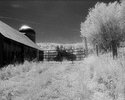I was not necessarily responding to you, Pentaxuser, but just providing overall impressions of these films based on what has most successfully worked for me personally. And I really don't want to get entangled is the ulterior variables of loose-end, low-end scanning experiments. It's not that I'm not sympathetic. I have a friend who wanted to shoot film rather than digital, but didn't have a darkroom yet in his new home, so used a changing bag to reel his film drums, went ahead and developed in drum in daylight, then scanned the film afterwards and tried to anticipate print results viewing on a screen. But it seldom comes out the same way when actually wet printing. He had good intentions, but three babies soon arrived, his anticipated darkroom space has gone to family use, and it might be decades before he even has the time to learn actual darkroom printing. People make it so darn complicated when they try to jump through all kinds of secondary hoops instead of just taking it one step at a time, hands-on in the darkroom. Learning exposure, development, and actual printing all need to be integrated together. Otherwise, it's just a big guess or juggling various conflicting opinions. Wouldn't you agree?






